
This edition of Directions in Highway Safety, GHSA’s member newsletter, features details on the U.S. DOT National Roadway Safety Strategy, 2022 GHSA Annual Meeting, Infrastructure Investment and Jobs Act (IIJA) updates, grant updates and new publications and resources.
Quick Links: Cover Story | Executive Director's Report | From Washington | State of the States | Did You Know? | From Our Perspective
New U.S. DOT National Roadway Safety Strategy Lays Out Roadmap to Zero
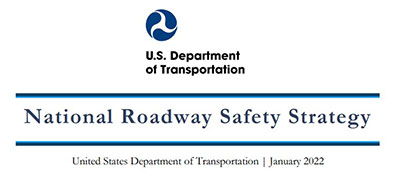 On January 27, U.S. Secretary of Transportation Pete Buttigieg announced a National Roadway Safety Strategy (NRSS) that summarizes the nation’s roadway safety status, adopts a national goal of zero roadway fatalities and describes the U.S. Department of Transportation’s (U.S. DOT) planned major safety initiatives in the coming years.
On January 27, U.S. Secretary of Transportation Pete Buttigieg announced a National Roadway Safety Strategy (NRSS) that summarizes the nation’s roadway safety status, adopts a national goal of zero roadway fatalities and describes the U.S. Department of Transportation’s (U.S. DOT) planned major safety initiatives in the coming years.
The strategy is based on the Safe System approach, a new paradigm that acknowledges human mistakes and vulnerability and designs a redundant system to protect all roadway users. The NRSS is structured around five Safe System elements: Safer People, Safer Roads, Safer Vehicles, Safer Speeds and Post-Crash Care. GHSA explored the Safe System approach in detail in the December report, Putting the Pieces Together: Addressing the Role of Behavioral Safety in the Safe System Approach.
The NRSS acknowledges that no single approach alone will be effective in getting us to zero. We need infrastructure improvements, behavioral interventions, vehicle safety enhancements, emergency medicine and all safety countermeasures working together. It recognizes the importance of a broad and shared responsibility for highway safety and discusses in detail the important role of human behavior in reducing crashes, injuries and deaths on our roads.
Over the last few years, there has been intense debate about the statistic 94 percent of crashes are the result of human error. This data point has been mostly discredited, but there is no doubt that dangerous driving behaviors are a major factor in traffic crashes. The NRSS reframes the impact of risky driving behaviors on road safety by acknowledging that “the overwhelming majority of serious and fatal crashes includes at least one human behavioral issue as a contributing factor.”
GHSA welcomes this statement and is pleased that the NRSS identifies Safer People and Safer Speeds as key objectives. Regarding the latter, you may recall that in April 2019, GHSA and the Insurance Institute for Highway Safety (IIHS) hosted a national speeding forum in Virginia. At that time, the safety community was concerned that speeding was a forgotten safety issue. GHSA’s continued advocacy, coupled with the Safe System approach’s call for speed management and speeding’s impact on the ongoing pedestrian safety crisis, confirms that a renewed focus on this risky behavior is necessary and long overdue.
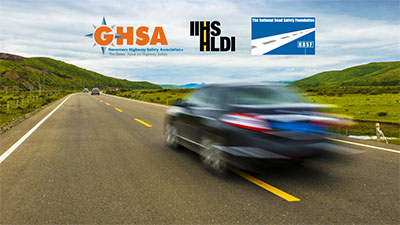 The NRSS includes several new commitments and future actions relevant to the State Highway Safety Offices (SHSOs). Within the speed management pillar of the strategy, U.S. DOT plans to launch a new multi-modal speed management program, revisit federal guidance on how speed limits are set and propose new pilot programs to advance use of automated enforcement (safety cameras). GHSA, IIHS and the National Roadway Safety Foundation have been partnering on multi-disciplinary speed management pilot programs that will offer a model that can be duplicated in states and communities.
The NRSS includes several new commitments and future actions relevant to the State Highway Safety Offices (SHSOs). Within the speed management pillar of the strategy, U.S. DOT plans to launch a new multi-modal speed management program, revisit federal guidance on how speed limits are set and propose new pilot programs to advance use of automated enforcement (safety cameras). GHSA, IIHS and the National Roadway Safety Foundation have been partnering on multi-disciplinary speed management pilot programs that will offer a model that can be duplicated in states and communities.
The NRSS acknowledges the central role of equity in highway safety and traffic enforcement. In response, the U.S. DOT plans to hold stakeholder meetings to discuss traffic enforcement and develop new training to help states implement safety programs more equitably. GHSA anticipates that U.S. DOT and NHTSA will follow the lead that many states have already pioneered and make changes to safety messaging to more closely align with the Safe System approach.
The NRSS also calls for state licensing agencies and the federal government to expand efforts to better identify unsafe drivers. For vehicle safety, in addition to a lengthy list of pending and future vehicle safety rulemakings, GHSA and its partners are especially excited for the implementation of the RIDE Act, which requires advanced driver impairment detection technology in all new vehicles. Finally, U.S. DOT will soon launch the new Safe Streets and Roads for All Program to provide grants to cities to implement Vision Zero initiatives.
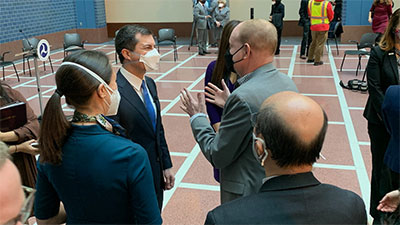
Secretary Buttigieg's announcement of the National
Roadway Safety Strategy in January.
GHSA played a pivotal role in helping shaped elements of the NRSS. Last fall, the U.S. DOT invited our association and several of our partners to participate in listening sessions that informed NRSS development. GHSA’s own work describing a vision for the equitable implementation of highway safety programs and the Safe System approach is clearly echoed in the document. GHSA Executive Director Jonathan Adkins was invited to an exclusive in-person launch event hosted by Secretary Buttigieg in Washington, D.C. GHSA anticipates a continued partnership with the U.S. DOT and NHTSA to implement NRSS and the Bipartisan Infrastructure Law as we work to reverse the upward trend in motor vehicle fatalities and save lives on the nation’s road.

Over the past few years, change has been one of the few constants in our lives and this applies to traffic safety as well. We need to continue to adapt to improve roadway safety for all. With this in mind, I’m excited to announce the theme for GHSA’s 2022 Annual Meeting, Redefining Possible: Traffic Safety in a Changing World, which will be held September 17–21 in Louisville, Kentucky. Team GHSA is hard at work firming up a great lineup of speakers, that we’re excited to confirm already includes:

Be sure to bookmark our Annual Meeting webpage and follow our social media channels (Twitter | Facebook | LinkedIn) to stay up to date on new speakers as they are confirmed. Registration opens in mid-May, so be sure to take advantage of the early bird rate!
As I mentioned earlier, we must continue to change and adapt to improve traffic safety. The National Highway Traffic Safety Administration (NHTSA) recently reported that 31,720 people were killed on U.S. roadways in the first nine months of 2021, a record 12% increase from the same period in 2020 and the most people killed on our roadways through the first nine months of any year since 2006. That’s why the newly released National Roadway Safety Strategy (NRSS), discussed in this issue’s cover story, is vital. The NRSS takes a Safe System approach to stemming the tide of unsafe driving behaviors that are unnecessarily claiming lives every day on our nation’s roadways.
Speaking of the Safe System approach, at the end of 2021 GHSA released, Putting the Pieces Together: Addressing the Role of Behavioral Safety in the Safe System Approach, making the case for the integral role of behavioral safety and road user responsibility in the Safe System approach to traffic safety. The report’s findings were discussed during two GHSA webinars on January 18 and February 10, which attracted more than 1,000 viewers. These webinars included informative presentations and question-and-answer sessions featuring traffic safety experts from AAA, Cambridge Systematics, the National Safety Council, NHTSA, the North Carolina Governor’s Highway Safety Program and Safe Kids Worldwide. GHSA Executive Board Vice Chair and California Office of Traffic Safety Director Barbara Rooney also shared an update on the progress her state is making implementing the Safe System approach. I encourage you to check out both webinars Addressing the Role of Behavioral Safety in the Safe System Approach and, Expanding Our Reach: The Role of State Highway Safety Offices in the Safe System Approach.
One thing that has not changed over the past two years is GHSA’s commitment to establishing partnerships that can help our membership advance highway safety. I’m excited to announce that we have teamed up with General Motors (GM) to address distracted driving. GM has provided funding to enable us to issue an action-oriented report that will offer a fresh look at combating this persistent but preventable problem. In addition, SHSOs will be eligible to apply for one of seven grants of up to $30,000 to implement recommendations detailed in the report. We’ll officially announce the collaboration with a satellite TV and radio tour during Distracted Driving Awareness Month. Stay tuned for more information on the report and this grant opportunity.
Speaking of partnerships, 2022 marks the 19th year of our collaboration with Ford Fund and the Ford Driving Skills for Life (Ford DSFL) hands-on ride and drive tour! The award-winning program helps teens develop critical safe driving skills and features a website with resources for teens and their parents. The 2022 tour will launch this April and include stops in more than ten cities. Be sure to check out what it’s like to attend a Ford Driving Skills For Life event.
Finally, I want to congratulate the Illinois Department of Transportation and everyone involved in planning the 2022 Lifesavers Conference, held recently in Chicago. I’ve heard many positive comments about the conference. In particular, it’s heartening to hear that Lifesavers offered sessions supporting equitable law enforcement and real-world examples for implementing the Safe System approach. If you weren’t able to attend, recordings of three of the plenary sessions are available on the Lifesavers website.
GHSA has hit the ground running in 2022, and I look forward to working with all of you to advance our collective goal of zero roadway fatalities.
Welcome New Members
GHSA is pleased to welcome the following new Associate Members. Click below to learn about their mission and services:
- Alabama Transportation Institute
- Catch You Later Foundation
- Erie Insurance
- National Association of Mutual Insurance Companies (NAMIC)
- PluggdIn
- Rekor Systems
- Safe Kids Worldwide

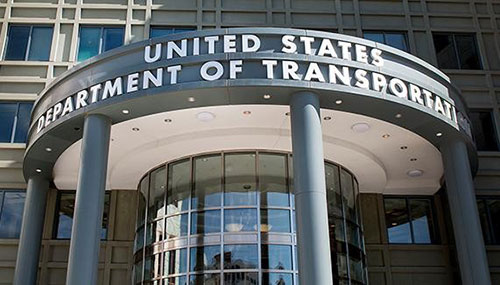 U.S. DOT, NHTSA and GHSA continue to prepare to implement last year’s Infrastructure Investment and Jobs Act (IIJA). Both NHTSA and the Federal Highway Administration (FHWA) launched new webpages on the new infrastructure reauthorization.
U.S. DOT, NHTSA and GHSA continue to prepare to implement last year’s Infrastructure Investment and Jobs Act (IIJA). Both NHTSA and the Federal Highway Administration (FHWA) launched new webpages on the new infrastructure reauthorization.
SHSOs will notice additional funding provided by the IIJA beginning with this fiscal year, including an infusion of separately budgeted $42 million in supplemental funding. After a series of Continuing Resolutions (CRs) temporarily extending FAST Act funding at Federal Fiscal Year (FFY) 2021 levels, Congress has approved the full budget for FY 2022. On December 17, 2021, NHTSA provided the first allocation of FFY 2022 funding to the states reflecting the first two CRs of the fiscal year and we anticipate that NHTSA will provide the full balance to the states soon. Though the congressional process to approve baseline funding to states is often delayed, NHTSA anticipates that over the next four years, it will be able to allocate the $42 million supplement to states relatively early in the fiscal year as these supplements will not be subject to future CRs.
Visitors to NHTSA’s state grants webpage will find two new FFY 2022 charts, one lists state grant awards to date, while the other addresses grant determinations. The IIJA now requires NHTSA to list all the reasons why a state was not awarded a Section 405 grant, which should help safety advocates make more targeted improvements to state traffic safety laws.
With major changes to NHTSA’s highway safety grant programs set to occur in FFY 2024, NHTSA began a process to revise the related regulations at C.F.R. 23 Part 1300. Late last December, GHSA sent NHTSA detailed recommendations for how future federal regulatory updates can promote the implementation of life-saving programs, ensure fidelity to the spirit and letter of Congressional directives, remove program barriers, minimize administrative barriers and ambiguity, and promote greater clarity in regulatory requirements.
The implementation of the IIJA also includes a new look at how NHTSA and the states measure highway safety performance. The IIJA directs NHTSA to collaborate with GHSA to update the 2008 Traffic Safety Performance Measures for States and Federal Agencies, which established a minimum set of performance measures for state highway safety plans.
Finally, NHTSA has operated without an Administrator for nearly five years. Last October the Biden administration nominated current NHTSA Deputy Administrator Steven Cliff to lead the agency. The Senate Commerce Committee approved Cliff’s nomination on February 2. During his December 2021 confirmation hearing, Cliff shared an update on the agency’s planned implementation of the new infrastructure law and ongoing agency efforts to clear a rulemaking backlog. The full Senate will now schedule a time to consider and vote on Cliff’s nomination. GHSA looks forward to Cliff assuming this critical role and to our ongoing partnership with NHTSA to advance highway safety.

A Holiday Success
GHSA and Uber partnered to award SHSOs in Colorado, Connecticut, Maryland, New Mexico and Texas a combination of grant funds and ride credits to support initiatives to help prevent impaired driving during the 2021 holiday season. The “Powered by Uber” grant program encouraged individuals who consumed alcohol or other impairing substances to use ride-hailing instead of putting themselves or others on the road at risk by driving impaired.
The SHSOs implemented successful campaigns between Thanksgiving and New Year’s Day that used a combination of social, earned and paid media to generate record use of the ride-hailing credits. In Maryland, for example, Governor Larry Hogan announced the campaign at a press event and via twitter, while television outlets across Connecticut ran stories highlighting the opportunity for holiday revelers to get a safe ride home. Within hours, both states had to temporarily suspend their campaigns to secure additional ride-credits. Meanwhile, in Colorado, the SHSO partnered with alcohol retailers in two counties with high rates of impaired driving crashes to encourage people hosting holiday gatherings to be the Ultimate Party Host by promoting the use of ride-hailing. Local television stations stopped by participating retail outlets to interview customers generating widespread public awareness of the safe ride home initiative.

Department of Transportation, discusses the state's holiday impaired
driving ride-hailing campaign with a television crew at a liquor store
in Colorado.

received a grant from GHSA and Uber to reduce impaired driving during the
holidays at the 18th annual Maryland Remembers ceremony held on
November 22, 2021. Photo courtesy of the Maryland Highway Safety Office.
To learn more about how each state leveraged this grant opportunity, check out the showcases on the GHSA website.
National Road Safety Foundation Provides Grants for Youth Active Transportation Initiatives
 New this year, GHSA is partnering with the National Road Safety Foundation (NRSF) to award grants totaling $75,000 to SHSOs in Connecticut, New York and Pennsylvania to work with community-based partners to promote safe youth mobility options like biking, walking or riding a scooter. The grants are critical as traffic crashes are one of the leading causes of death for children in the U.S. As pedestrian and bicyclist fatalities continue to rise and disproportionately impact communities of color, it is important that states develop and implement new programs to educate children, youth and teens about active mobility safety practices. This funding is enabling the three states to work with local partners to reach diverse and low-income communities, where walking and biking is more common.
New this year, GHSA is partnering with the National Road Safety Foundation (NRSF) to award grants totaling $75,000 to SHSOs in Connecticut, New York and Pennsylvania to work with community-based partners to promote safe youth mobility options like biking, walking or riding a scooter. The grants are critical as traffic crashes are one of the leading causes of death for children in the U.S. As pedestrian and bicyclist fatalities continue to rise and disproportionately impact communities of color, it is important that states develop and implement new programs to educate children, youth and teens about active mobility safety practices. This funding is enabling the three states to work with local partners to reach diverse and low-income communities, where walking and biking is more common.
In Pennsylvania, the SHSO is partnering with United Way of Erie County, to implement and expand local programs to create safe walking routes to a community elementary school. In partnership with the New York City Department of Transportation, New York’s SHSO is providing peer-to-peer outreach to promote scooter, pedestrian and bicycle safety in the Bronx, one of the nation’s most diverse communities. The Connecticut Highway Safety Office is collaborating with the Connecticut Children’s Injury Prevention Center and the Yard Goats Youth Ambassador Program to recruit and train Hartford teens to educate their peers about pedestrian and bicycle safety. Learn more about how these states are using NRSF grant funds to promote safe active mobility in GHSA’s news release.
Funding Available for Cutting Edge Impaired Driving Tactics
For the eighth consecutive year, GHSA and the Foundation for Advancing Alcohol Responsibility (Responsibility.org) are partnering to award grants to SHSOs to bolster efforts to combat impaired driving. Since 2016, GHSA and Responsibility.org have awarded more than $800,000 in unrestricted funds that 22 states have used to offer specialized law enforcement training, reduce blood and alcohol testing backlogs, pilot and evaluate the use of screening and assessment tools, conduct wet and green labs, and more.
This year, SHSOs are encouraged to submit applications focusing on the detection and prevention of multi-substance impaired driving and/or strategies to combat high-risk impaired drivers. GHSA will announce the grant recipients this summer. In the meantime, be sure to check out the showcase of past SHSO initiatives here.

Traffic Deaths Decrease After Utah Enacts Lower BAC Law
On December 30, 2018, Utah became the first state to lower their legal driving limit from .08 to .05 g/dl. NHTSA conducted a comprehensive evaluation of the impacts of Utah’s per se law and found it resulted in a significant decrease in traffic deaths. At the same time, there was no adverse economic impacts after the change took effect. Read the full report and Traffic Tech, which discuss the law’s impact on DUI arrests, public awareness, alcohol sales, tax revenues and tourism.
New Campaign: National Passenger Safety Week 2022
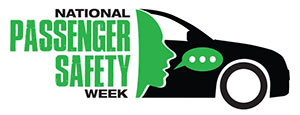 We Save Lives and the National Road Safety Foundation launched the first ever National Passenger Safety Week, January 23-30, 2022. More than 52 partners – including GHSA, SHSOs and several Associate Members – signed on to help promote the campaign. The goal is to empower passengers to “SPEAK UP” when the driver is engaging in unsafe behaviors that put them and other road users at risk. The first observance generated national media coverage at a time when new strategies are needed to stem the dangerous uptick in risky driving that is claiming lives nationwide. To learn more about the campaign and sign on as a partner, visit here.
We Save Lives and the National Road Safety Foundation launched the first ever National Passenger Safety Week, January 23-30, 2022. More than 52 partners – including GHSA, SHSOs and several Associate Members – signed on to help promote the campaign. The goal is to empower passengers to “SPEAK UP” when the driver is engaging in unsafe behaviors that put them and other road users at risk. The first observance generated national media coverage at a time when new strategies are needed to stem the dangerous uptick in risky driving that is claiming lives nationwide. To learn more about the campaign and sign on as a partner, visit here.
Two Police Chiefs Talk about Equity and Traffic Stops
 Ensuring equity for all must be a central tenet of law enforcement, as officers work to serve all citizens in their communities. The National Law Enforcement Liaison Program (NLELP) recently hosted a webinar during which Mitchell Davis, Chief of the Hazel Crest Police Department and President of the Illinois Chiefs of Police Association, and Tempe Police Chief Jeff Glover engaged with NLELP Manager Tim Burrow in a discussion about equity. Both shared how their own experiences and lessons learned are helping to shape the future of law enforcement and how their officers conduct traffic stop. “We deal with the issues of biases and culture in law enforcement. You have to really take a deep dive in digging into that and trying to understand exactly how do you change that culture,” said Chief Glover. You can view this important, informative and timely webinar on the NLELP website.
Ensuring equity for all must be a central tenet of law enforcement, as officers work to serve all citizens in their communities. The National Law Enforcement Liaison Program (NLELP) recently hosted a webinar during which Mitchell Davis, Chief of the Hazel Crest Police Department and President of the Illinois Chiefs of Police Association, and Tempe Police Chief Jeff Glover engaged with NLELP Manager Tim Burrow in a discussion about equity. Both shared how their own experiences and lessons learned are helping to shape the future of law enforcement and how their officers conduct traffic stop. “We deal with the issues of biases and culture in law enforcement. You have to really take a deep dive in digging into that and trying to understand exactly how do you change that culture,” said Chief Glover. You can view this important, informative and timely webinar on the NLELP website.
U.S. Traffic Deaths Continued to Climb in 2021
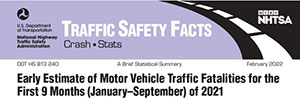 NHTSA projects traffic fatalities for the first nine months of 2021 to be 31,720 people, a 12% increase from the same period in 2020. This projection is the highest number of fatalities during the first nine months of any year since 2006 and the highest percentage increase during the first nine months in the Fatality Analysis Reporting System’s (FARS) history. You can view the report, which includes total fatalities and fatality rates by quarter as well as regional and state details online. Separately, NHTSA issued its final 2020 figures on traffic crashes, injuries and fatalities. A total of 38,824 people died on U.S. roads in 2020 and in 45% of fatal crashes, the driver was either impaired, speeding or not wearing a seat belt.
NHTSA projects traffic fatalities for the first nine months of 2021 to be 31,720 people, a 12% increase from the same period in 2020. This projection is the highest number of fatalities during the first nine months of any year since 2006 and the highest percentage increase during the first nine months in the Fatality Analysis Reporting System’s (FARS) history. You can view the report, which includes total fatalities and fatality rates by quarter as well as regional and state details online. Separately, NHTSA issued its final 2020 figures on traffic crashes, injuries and fatalities. A total of 38,824 people died on U.S. roads in 2020 and in 45% of fatal crashes, the driver was either impaired, speeding or not wearing a seat belt.
Detecting Change in Community Traffic Safety Attitudes
 NHTSA recently released a report that discusses several methods for increasing the rigor of community traffic safety program evaluations. It presents two nonprobability sampling techniques – opt-in online panel surveys and intercept surveys – and identifies and describes existing data sources that may be of use to traffic safety officials looking to evaluate their road safety programs. All traffic safety programs should be evaluated to determine their effectiveness. This new research can help SHSOs and their subrecipients ensure evaluation efficacy. Check out the Traffic Tech or full report and be sure to share it with your evaluation partners.
NHTSA recently released a report that discusses several methods for increasing the rigor of community traffic safety program evaluations. It presents two nonprobability sampling techniques – opt-in online panel surveys and intercept surveys – and identifies and describes existing data sources that may be of use to traffic safety officials looking to evaluate their road safety programs. All traffic safety programs should be evaluated to determine their effectiveness. This new research can help SHSOs and their subrecipients ensure evaluation efficacy. Check out the Traffic Tech or full report and be sure to share it with your evaluation partners.
NHTSA Recruiting Safety Experts to Join Assessment Teams
Do you have the expertise to help SHSOs strengthen their traffic safety programs? NTHSA is recruiting experienced traffic safety professionals to assess various elements of state highway safety programs, assist in strategic planning and identify opportunities to expand initiatives among stakeholders. The qualifications to serve as a Safety Program Assessment Subject Matter expert include extensive experience with traffic safety issues, strong writing skills evidenced by published works, and the ability to work with as a team to develop recommendations and strategies. A brochure explaining the assessment process and the role of an assessor can be found on the GHSA website. Questions about this exciting opportunity should be directed to NHTSA.
Member Spotlight
GHSA appreciates the support of our Associate Members, who are committed to working with us to achieve a zero fatalities goal. This month, we're featuring Staver Accident Injury Lawyers, P.C.'s Patrick Gill and Kelly Hernandez with Nationwide's Personal Lines Telematics team.
Want to be featured in the next issue of Directions? Email Kerry Chausmer.

 Brock Aun
Brock Aun
HAAS Alert
As many GHSA members know, the Infrastructure Investment and Jobs Act (IIJA) passed last fall includes more than $500 billion of funding to improve and enhance transportation in communities nationwide. To date, much of the public and media coverage on the IIJA has understandably focused on the massive investments it will provide for roads, bridges and safety efforts. But there are also new changes within the National Priority Safety Program (Section 405) that expand opportunities for State Highway Safety Offices (SHSOs) to leverage high-impact, low-cost technologies and products to advance road safety.
One of those programs, Section 405(h) - Preventing Roadside Deaths, as renumbered by the IIJA, provides $15 million in dedicated funding to “prevent death and injury from crashes involving motor vehicles striking other vehicles and individuals stopped at the roadside.” The addition of this new category in Section 405 highlights the importance of protecting professionals and other vulnerable users that work on and adjacent to the nation’s roads. This funding is addressing a vital road safety concern. The Section 405(h) program specifically allows SHSOs to utilize this funding “to purchase and deploy digital alert technology.”
Digital alerting, which is already deployed on fleets in every state, is a versatile solution that can reduce distracted driving, protect vulnerable road users and enhance safety in even the most rural communities. The technology enables authorized users to notify drivers through vehicle dashboards and navigation apps to slow down and move over. These alerts are transmitted via existing cellular networks and do not require any roadside units or other infrastructure development. The Federal Highway Administration recently reported that the Pennsylvania Turnpike Commission used digital alerting to reduce crashes involving roadside assistance vehicles from 30 in 2018 to zero in 2020. A 2021 study by Purdue University found that queue trucks (vehicles placed in advance of work zones where stopped or slowed traffic could present a risk to motorists or workers) equipped with digital alerting reduced hard braking incidents by 80 percent, significantly lowering the potential for secondary crashes.
Many vehicles, such as emergency and roadside assistance, work zone and tow trucks, can be equipped with digital alerting solutions that can send alerts to drivers prompting them to slow down, move over and/or take other actions that reduce the potential for a crash. Millions of vehicles on the road today, including well-known brands like Dodge, Ram, Chrysler and Jeep, receive these alerts in the infotainment screen or dashboard of the vehicle. In addition, these alerts are available to drivers through navigation platforms such as Waze, making it accessible to all motorists regardless of the vehicle they drive.
The expansion of funding in the 405(h) program and increased focus on preventing roadside deaths reinforces U.S. Transportation Secretary Pete Buttigieg’s recent call for new and innovative road safety solutions. Funding low-cost safety equipment like digital alerting will expand life-saving protection for first responders, state and municipal DOT workers, construction workers and other professionals who spend much of their days exposed to risk on the roadway. The IIJA provides SHSOs another impactful avenue for deploying the Safe Systems approach to preventing crashes and saving lives.


